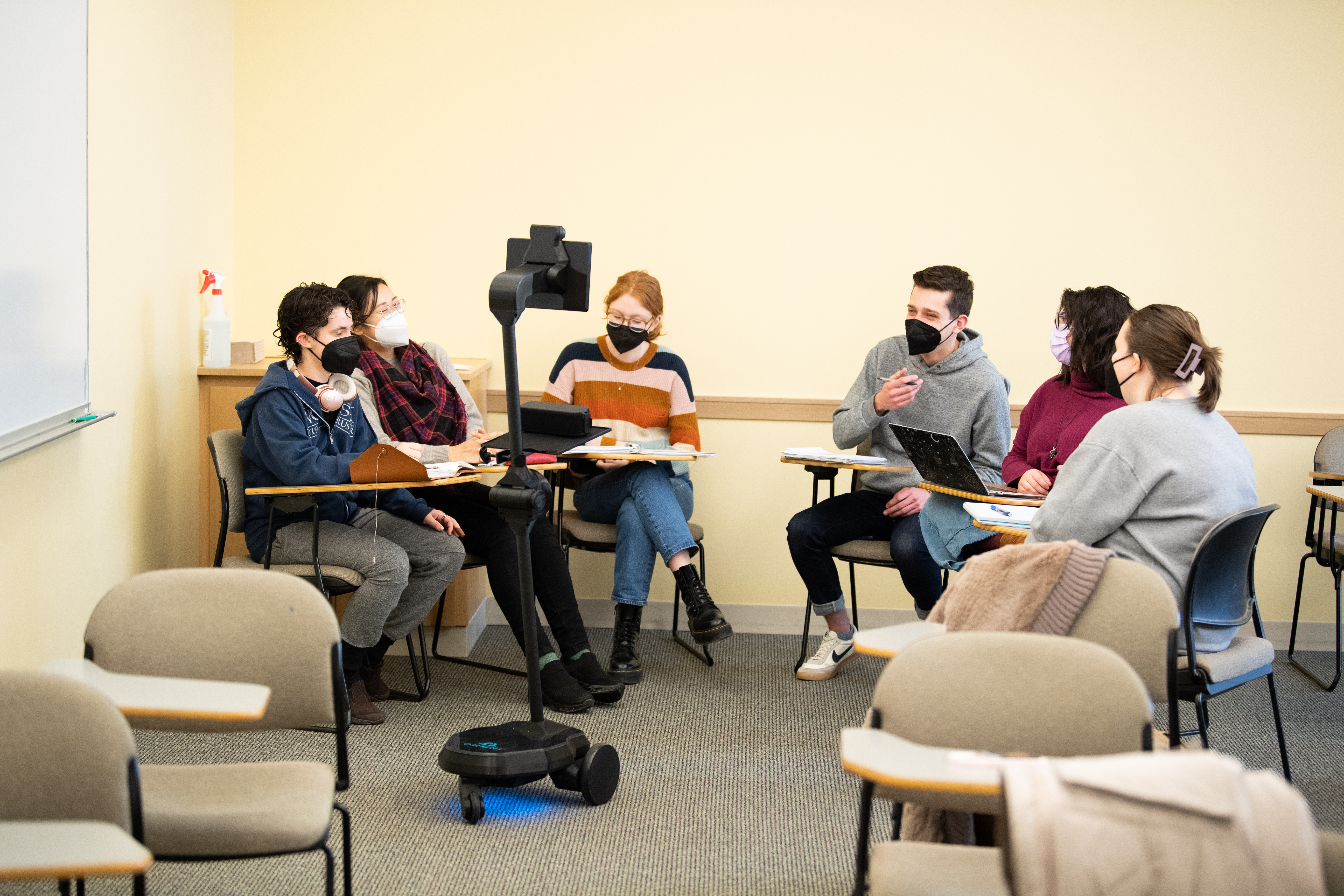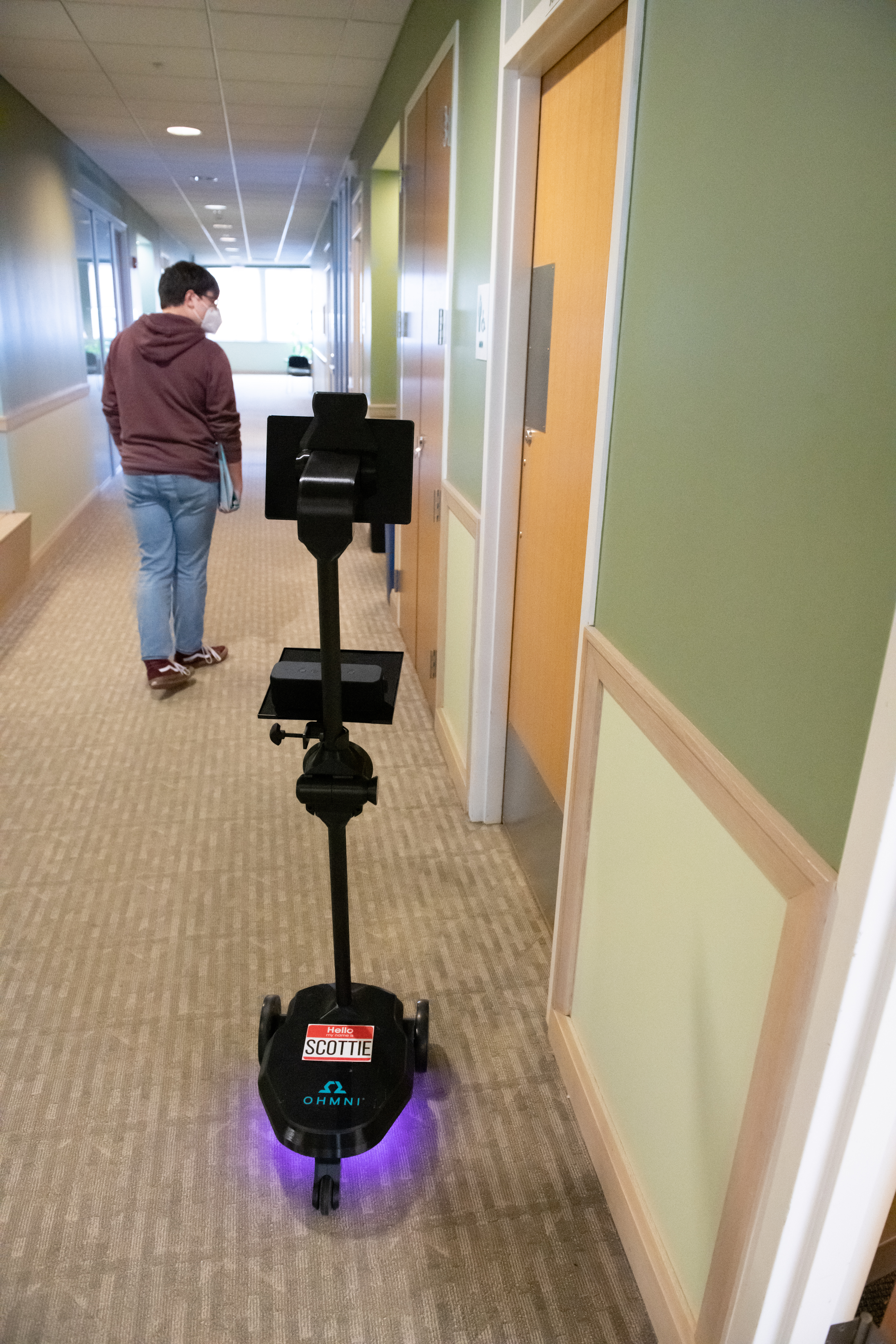You have /5 articles left.
Sign up for a free account or log in.
Anne Nurse (right) teaches her criminology class.
Matt Dilyard/The College of Wooster
Students sit in rows facing the front of the classroom where Anne Nurse, a professor of sociology at the College of Wooster, sits on a desk and lectures. Sometimes the students gather in circles for small-group discussions. The criminology class looks like any other course on the Ohio campus—except for the robots.
Six out of the 19 students in the course are incarcerated and attending class via robotic stand-ins, which the incarcerated students control remotely from Indian River Juvenile Correctional Facility, some 27 miles away.
Each “telepresence robot” resembles a motor scooter with an iPad attached. The incarcerated students’ faces appear on the screens. Using computers in the prison, the students can control the angle of the robot’s camera, so they can look at fellow students or the professor, and they can choose where the robot goes using the arrow keys. The robots congregate at the front of the room when Nurse is lecturing, or they can follow fellow students to different sides of the room for smaller-group activities.
Nurse said the robots aren’t a substitute for in-person teaching in the prison, but they have been a “terrific solution” this semester during the pandemic.
“A lot of incarcerated youth want to go to college, but they’re just not sure how to do that, and we’re able to bring that to them and show them what college is like,” Nurse said. “It’s an opportunity for them to experience being a college student. Especially because they’ve been so isolated over the last two years, I think it’s really meaningful that we were able to take them out of that space and into our space.”
Nurse’s course, which began in January, would normally involve bringing Wooster students to the prison facility to learn alongside their incarcerated peers, part of a program the college has run since 2006. Nurse was trained by the Inside-Out Prison Exchange Program at Temple University, which encourages colleges and universities to offer classes in prisons and include nonincarcerated students from their campuses. After the pandemic shut down the course in spring 2020, Nurse hoped students would be able to return to the correctional facility this spring. But the Omicron variant quickly spread and put the prison on lockdown.
Nurse said her options for engaging incarcerated students felt limited. Her plan was to use a videoconferencing platform, such as Microsoft Teams, and project images on a screen at the front of the class. But she found students in hybrid courses didn’t like that approach. It made them feel self-conscious and “awkward” and removed from their peers, she said.
The suggestion to try robots came from a colleague in the education department, Sarah Dunlap, director of field, assessment and candidate engagement. The college’s education students used robots in fall 2020 to do their fieldwork in K-12 schools, virtually spending time in the schools by navigating robots around the classrooms, an experience “very close to being there in person,” Dunlap said.
The College of Wooster isn’t the only institution using these robots as a remote learning tool. OhmniLabs, the company that created this particular telepresence robot, has worked with 161 universities, colleges and academic research labs since 2018. While that figure also includes colleges using a robot to disinfect campus spaces, the majority are institutions using telepresence robots to teach courses or to represent students virtually, according to the company.
Colleges and universities have been experimenting with telepresence robots to some degree since at least 2014, but the growth of the trend is a “relatively recent development” that has “been increasing in the last several years,” often to serve students with health issues, said Christine Greenhow, associate professor of educational psychology and educational technology at Michigan State University.
For example, a pregnant student on bed rest used a telepresence robot to attend law school classes at the University of California, Irvine, in 2017, The Baltimore Sun reported. A University of Maryland–Baltimore County graduate student with a rare genetic disorder attended classes and ultimately defended her dissertation via robot, according to The Washington Post. Arizona State University's Thunderbird School of Global Management rented robots so graduates could virtually walk across the stage for their commencement in 2020.
Greenhow has been using robots in her classroom as a part of a hybrid doctoral program since 2015. In 2017 she published a study that found that remote students felt more engaged using the robots compared to Zoom and other videoconferencing platforms.
“There’s a lot of distance between people participating through videoconferencing and those physically present,” she said. “If you can embody someone in a robot—so take those online students and give them a physical body in the classroom—the idea was that it would help break down some of that what we call transactional distance.”
Greenhow believes creating a more personal experience through robots can improve increase the retention rate of remote students.
“We know from studies of students’ persistence and performance in higher education that when students feel a greater sense of belonging to the campus community, with their instructor and other students, they do better,” she said. “They stay in school at higher rates. They graduate more. That sense of belonging to a classroom community is really important, and whatever you as an instructor can do to break down that distance that online students often feel when they’re joining an in-person class, the better.”
At the College of Wooster, three robots rove around the classroom. The incarcerated students operate the machines in pairs, because they live in three different housing units in the prison, each with one computer. The robots took some getting used to for both Nurse and her in-person students.
“It felt completely surreal,” Nurse said. “It felt like I was in some kind of sci-fi movie at first.”
Austin Piatt, a sophomore at the College of Wooster, said Nurse told her students about the plan to bring robots into the classroom, and they readily agreed. Piatt said he felt both excited and nervous about the first few classes.
“Everyone’s nervous to begin with,” he said. “The inside students have never interacted with college students, and this is their first college experience. Us outside students are kind of nervous to interact with incarcerated students. So, there’s that, but then having the robots kind of added this extra level of intimidation, I guess.”
But Piatt said he’s surprised how normal it now feels to interact with his incarcerated peers via the robots. They’ve learned each other’s names. They greet each other and say, “’bye, see you next week” when they leave the classroom.
“It’s fascinating to me that we have this technology available and it allows us to interact in a way that is normal, even if the experience itself is relatively pathbreaking,” he said.
Ann Schwartzman, coordinator of local networking and support for the Inside-Out Prison Exchange Program in Philadelphia, said the college-in-prison instructors she works with have largely arranged to connect incarcerated students with their peers on campus over Zoom or shifted their focus to teaching formerly incarcerated students during the pandemic.
Lori Pompa, founder and executive director of the program, said she hasn’t heard of other instructors trained by the program using telepresence robots to engage incarcerated students during the pandemic.
She emphasized the educational value of incarcerated students and students on campuses studying together.
For college students, it’s a form of “civic engagement” and “community-based learning,” she said. And for “the folks on the inside … a lot of times there are people who have grown up in very economically depressed areas where the education system is really not good. Maybe they dropped out because they just lost interest in schools. What they do then is they come to this experience and they see themselves, sometimes for the first time, as being smart and capable and creative and able to write and—I’ve heard this more than once—able to keep up with ‘real college students.’”
Nurse said, even before the pandemic, there were always obstacles that sometimes got in the way of visiting her incarcerated students in person, such as security lockdowns. So she believes the robots may be useful as a “backup” even after the pandemic.
Piatt hopes professors at other colleges and universities will consider using telepresence robots to bring incarcerated students into their classrooms virtually, not only to continue their education but also to help them feel less isolated.
“I hope that more institutions here in the state and across the country try to adapt something similar to this,” he said. “Especially during the pandemic, I know it’s been incredibly difficult for the inside students, because they haven’t had the same interaction that they could have had if there weren’t restrictions on visitation … The carceral system is supposed to be rehabilitative, and this is an important part of that.”





